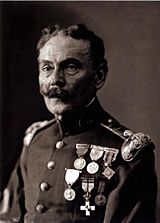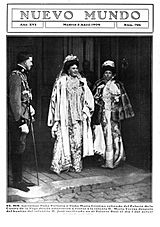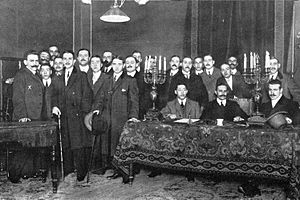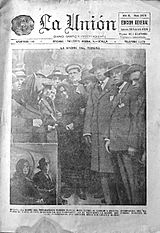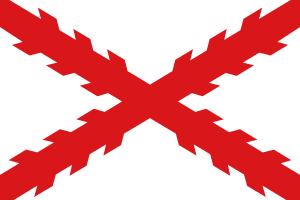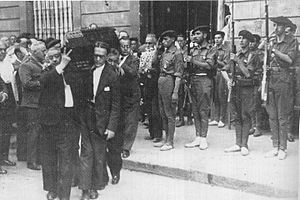Domingo Tejera de Quesada facts for kids
Quick facts for kids
Domingo Tejera de Quesada
|
|
|---|---|
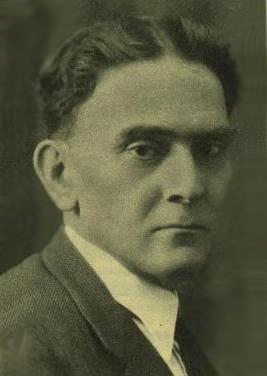 |
|
| Born |
Domingo Tejera de Quesada
1881 Las Palmas, Spain
|
| Died | 1944 (aged 62–63) Seville, Spain
|
| Nationality | Spanish |
| Occupation | journalist |
| Known for | publisher |
| Political party | Carlism |
Domingo Tejera de Quesada (1881–1944) was a Spanish publisher and journalist. From 1911 to 1913, he managed an illustrated magazine in Madrid called Nuevo Mundo. Later, from 1922 to 1939, he led a daily newspaper in Seville called La Unión. He also worked for other smaller newspapers.
Domingo Tejera became well-known as a war correspondent for the newspaper ABC between 1914 and 1917. In politics, he first supported a group called the Mauristas within the Conservative Party. Later, he became a strong supporter of Traditionalist ideas and was a key voice for the Carlist movement. His most important political role was from 1933 to 1936, when he served as a Carlist representative in the Spanish parliament, the Cortes.
Contents
Family and Early Life
The Tejera family came from Northern Spain. Domingo's grandfather, Santiago Tejera, passed away young during a cholera outbreak in the 1850s. His grandmother, Dominica Ossavarry, was the granddaughter of a painter. Domingo's father, Santiago Tejera Ossavarry (1852-1936), first studied to be a priest. However, at 17, he decided to join the military as a musician.
Santiago Tejera Ossavarry directed a military band in Gran Canaria until he retired in 1914. He was famous in Las Palmas because his band played for the city every Thursday. After retiring, he became an organist at the cathedral. He also wrote music, including some zarzuelas (a Spanish musical play) that are still performed today. Later in life, he faced financial difficulties, and the local government (the ayuntamiento) bought the rights to his music to help him.
Domingo's mother was María Quesada Déniz (died 1920). Domingo had two brothers. His older brother, Santiago Tejera Quesada, was a painter but died young in 1916. Domingo grew up surrounded by art, music, and publishing. He started writing from a young age. He later moved to Madrid and studied law at Universidad Central. Around this time, he began working for various newspapers and joined the team of Nuevo Mundo. He even traveled to Cuba as a correspondent for the magazine.
In 1910, Domingo married Emilia García Nogales in Madrid. Sadly, she passed away just a year later in 1911, and they had no children. In 1917, Domingo married Teresa Arroyo Mateo. They had many children between the late 1910s and early 1930s. Some of his children joined religious orders. His son, Manuel Tejera Arroyo, became a leader at a Jesuit college in Seville. Another son, Santiago Tejera Arroyo, supported the Carlists and fought in the Spanish Civil War. He later became known as the manager of the football club Real Betis in Seville.
Early Career (1907-1918)
In his mid-20s, Domingo Tejera started working with José del Perojo, a conservative politician. Perojo was a co-owner of Nuevo Mundo, a popular magazine in Madrid. In 1906, Tejera began writing for its weekly addition, Por Esos Mundos, and joined the main editorial team. By 1909, he was traveling as a correspondent to Cuba.
After Perojo's death, Nuevo Mundo changed owners. In 1911, Tejera was chosen as the new editor-in-chief of the magazine. He managed Nuevo Mundo for about two years before leaving in 1913.
When World War I began, Tejera started writing for the Madrid newspaper ABC. From 1914 to 1917, he wrote 82 articles about the war. He used the pen-name "R. Schneider." His articles often showed a clear support for Germany and Austria-Hungary, known as the Central Powers. He even suggested that Russia caused the war. He also wrote for other newspapers like Ilustración Española y Americana and La Acción.
Through José Perojo, Tejera became involved with the right-wing part of the conservative party, led by Antonio Maura. In the early 1910s, he became more active in politics in both the Canary Islands and Madrid. He gave talks to young conservative groups. He was also a strong voice against dividing the Canary Islands into two provinces, supporting Gran Canaria over Tenerife. By 1914-1915, he was a leader among young Maurista supporters in Madrid. In 1918, he tried to become a representative for the Canary Islands in the Cortes, but he did not win.
Experienced Journalist (1918-1931)
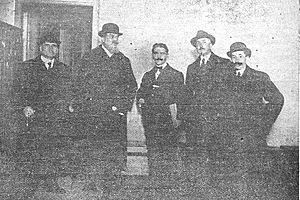
In 1918, Tejera became the director of a Madrid newspaper called El Día. He later worked for El Debate, a Catholic newspaper in Madrid. From 1919 to 1920, he wrote a column about what was happening in parliament. In 1920, he moved to Seville to manage El Correo de Andalucía, a local newspaper partly controlled by the archbishop. He led this paper until 1923.
In 1922, Tejera took over another Seville newspaper, La Unión. He worked to modernize the newspaper. His relationship with the military was not always good. In 1926, he faced a legal case for supposedly insulting the military when discussing the Rif War in Morocco. He also had disagreements with other journalists in Seville. Despite this, he continued his work and gave a lecture at a press conference in Madrid in 1927. Even though he started having some health issues as he approached 50, they did not stop his work. He always felt connected to the Canary Islands and promoted them.
In 1930, Tejera published a 360-page book called Los parásitos del trono (The Parasites of the Throne). The book discussed Spanish politics from 1907 to 1923. It was part of a public discussion about Spain's future after the fall of the Primo de Rivera dictatorship. In his book, Tejera strongly criticized almost all politicians of the time, saying they ruined national politics with their arguments. He believed the 1876 constitution was no longer working.
The book was strongly monarchist, meaning it supported the king. Tejera felt that King Alfonso XIII could not stop political problems because of the constitution. He called for a future system with a strong leader, possibly with more power for the king. The book was widely talked about in the newspapers.
Anti-Republican Crusader (1931-1936)
When the Second Spanish Republic was declared in 1931, La Unión became much more outspoken. The newspaper strongly opposed the new republican laws, saying they went against Spanish traditions. In late 1931, Tejera was attacked in the street.
During a brief takeover of Seville by General Sanjurjo in 1932, La Unión published an editorial saying Spain needed "healthier institutions." This led to the newspaper being temporarily shut down. Because of the strong political feelings at the time, La Unión became very popular, selling about 5,000 copies. In late 1932, the company also started a newspaper in Cádiz called La Información and took control of Diario de Jeréz. Tejera briefly left La Unión to manage La Información, and all three newspapers worked closely together.
Some historians say that in the early 1930s, Tejera became close to a group called Acción Nacional. Others say he moved towards Integrism, a very traditional Catholic movement. By mid-1933, newspapers were calling him a "traditionalist from Seville."
During the election campaign of late 1933, Tejera ran as a candidate for a right-wing group in Seville. He was first seen as an independent, then as a traditionalist. The campaign was very difficult; his car was once hit with stones, and he was arrested for having illegal firearms. Despite this, Tejera was elected. He then sent a message to the Carlist leader, Rodezno, saying he wanted to join the Carlists.
From late 1933, Tejera was clearly linked to the Carlists. He spoke in parliament only sometimes, focusing more on spreading Carlist ideas. La Unión became very aggressive in its articles and was the most punished newspaper in Spain. Tejera faced 63 legal cases, and the newspaper's offices were attacked many times. By mid-1934, the fines totaled 20,000 pesetas.
Tejera participated in Carlist meetings in Andalusia and the Canary Islands. In 1934, he became the Carlist party leader in the islands. That same year, he joined the Carlist Council of Culture, which protected the party's ideas. He also wrote for the Carlist intellectual magazine Tradición and started a new party newspaper in Las Palmas, becoming its director. He often warned against certain influences he saw as dangerous. However, he also showed some surprising views, like a degree of sympathy for anarchists.
Later Years (1936-1944)
Tejera was involved in the Carlist plan against the Republic in 1936. He believed the Carlists should join a coup organized by the military. After Seville was taken by the rebels in July 1936, he stopped managing La Unión. At 55 years old, he joined the Carlist militia called requeté. He was part of the Tercio Virgen de los Reyes battalion in Andalusia. In October, he was slightly injured during fighting in the Córdoba province and returned to Seville for treatment as a captain in the requeté.
In early 1937, Tejera took part in party discussions about being forced to merge into a new state party. He was worried about military pressure and opposed joining Falange unless Spain was clearly declared a traditionalist monarchy. His view was not shared by the majority. After the forced unification in 1937, Tejera did not join the new party, FET. He continued to attend Carlist-only events, like funerals for fallen requeté members.
La Unión was not taken over by the new Falangist propaganda machine because it was privately owned. However, it faced increasing pressure from the government. A new press law in 1938 aimed to close independent newspapers. Tejera was seen by the military as someone who disagreed and caused trouble. To save La Unión, he resigned and officially handed over its management to another Carlist, Melchor Ferrer. But the plan did not work. In 1939, Tejera was investigated for spreading "alarming news," and La Unión was forced to close on December 31, 1939.
As a Carlist who refused to support the new national-syndicalist government, Tejera faced various punishments from 1940 onwards. These included a three-month arrest in 1941. Since he could no longer publish in newspapers, Tejera formed a history team with Ferrer and another Carlist writer, José F. Acedo Castilla, in the early 1940s. They began writing a detailed, official history of Carlism. This big project resulted in a multi-volume series called Historia del tradicionalismo español. Six volumes were published before Tejera's death.
While Ferrer is usually seen as the main writer, Tejera and Acedo were important "collaborators." Tejera passed away in 1944 from bronchopneumonia. Five more volumes were published after his death until 1948, and they were still credited to all three authors.
See also
 In Spanish: Domingo Tejera de Quesada para niños
In Spanish: Domingo Tejera de Quesada para niños


